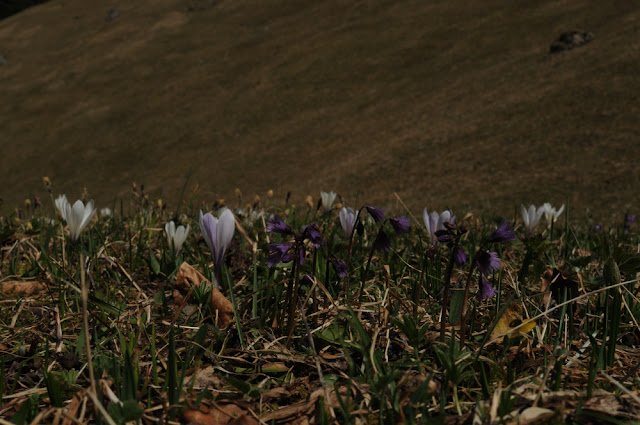February already. Where is the year going? The days are lengthening rapidly and the snow has now melted; just a few dirt-encrusted patches of white here and there in the most shady nooks bears testament to the blanket that covered us in January. When the weather is clear and the mountains are visible, it is possible to chart the gradual upward climb of the snowline, but days with clear skies are rather sparse at the moment: either it is grey and mild, or sunny and hazy. Or it rains.
The most obvious response to the change in temperature and day-length is, of course, from the birds. Suddenly there is song all around - the two-tone repetitive 'tee-tah' of
Great Tits the most striking to start with. They were quickly joined by drumming
Great Spotted Woodpeckers and the slightly manic laughter of
Green Woodpeckers. Listen with more than half an ear and you will hear the similar, yet somewhat more mournful song of
Grey-headed Woodpeckers, which seem to be widespread in the local area. Over the last week a
Black Woodpecker has added a wild, ringing 'klooouuu' to the mix too.
A swelling chorus of
Chaffinches is emerging - for now most of the males rather hesitantly launching their songs, so that they fade out into a jumble of notes soon after starting, but it won't be long before they ring loud in the woods and gardens.
Mistle Thrushes and
Blackbirds have also begun to polish up their notes for the coming spring. All in all, it won't be long before a proper dawn chorus is waking us each day and the first trans-Saharan migrants will start filtering through on their way north. A smart male Black Redstart feeding at the foot of the Schloss Montfort last week could well have been a bird moving back north from the Mediterranean, as could the little flock of Serins feeding in the asparagus fields on the way down to the kindergarten on Friday.
The ground is still cold though, so the plants are not yet really starting to move: a few fresh-looking leaves of Lesser Celandine and some new shoots of Greater Pond Sedge all the evidence that I can find of new growth just yet. It won't be long, though, before we can start to fossick through the woods and meadows to see what there is to offer here. A promise of warmer weather next week suggests that the local beavers will be starting to get out and about again: perhaps a chance to use the camera trap again for something more exotic (to me) than foxes and Roe Deer!
 |
| Though there aren't many juicy plants to be seen at present, there is still colour and interest to be found in bryophytes and fungi in the woods. |
 |
| A gratuitous patch of Radula complanata |
A recent visit to an old stamping ground was productive. The Rheindelta on the southern shore of the Bodensee is a long pair of artificial banks which channel the river Rhine out into the lake for a couple of kilometres. The bay just to the west of the river is one of the larger areas of shallow water in the lake and thus proves attractive to waterfowl. A calm day was impetus enough to go back and explore for the first time in thirteen years (how did that happen?!) and show the children some ducks.
The Fussacher Bucht did not disappoint. The bay was three-quarters frozen, so birds were concentrated near the lagoons and, despite an appalling winter for wildfowl on the lake overall, there were still enough birds to impress two small children. The duck flock was two or three thousand strong, divided equally between Red-crested Pochard, Tufted Duck and Common Pochard, with a smattering of Goldeneye around the fringes. Sprinklings of Coot, Whooper and Mute Swans, Caspian Gulls and Goosander added a little variety to the mix, while a bevy of cold-looking Grey Herons and Great Egrets speckled the banks. A lone fox on the ice caused mild alarm among the ducks for a while, but stood no chance of snaring any but the most dim-witted of them and eventually trotted gently back towards the reed fringe of the Rohrspitz.
 |
| Mixed ducks (all the specks at the back) in the Fussacher Bucht - a small group of Red-crested Pochard lurk in the foreground |

























